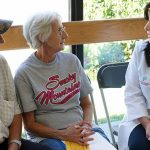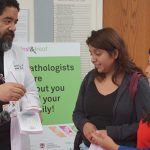Hillary’s Story: The Many Faces of See, Test & Treat
It’s possible that a post about See, Test & Treat on Facebook saved Hillary Ward’s life.
On a Friday evening last February, Hillary had the TV on in the background while she was scrolling through Facebook. She navigated over to a private Facebook group that is limited to her neighbors in Ypsilanti, Michigan.
A hard-working self-employed realtor, Hillary is there for her clients whenever and wherever they need her. But there was one need for herself that she had never addressed. With her 50th birthday just weeks away, Hillary had never had a mammogram.
Though she had no family history of breast cancer, she had been thinking about having a mammogram since she turned 40, the age at which women are recommended to start this screening.
“Because I am uninsured I don’t see the doctor often,” Hillary said. Every time a mammogram was recommended, it was a reminder that she couldn’t afford it.
Hillary and her husband, who works at a local business, were briefly insured last year, through the Affordable Care Act marketplace. “We make enough to get by,” said Hillary, “but we’re not making big money.” Then premiums more than doubled and the annual deductible was out of reach. “We made a difficult decision to forgo insurance in order to make ends meet. [Our plan was to] hope and pray that things would get straightened out for when we were older.”
This was all on her mind that fateful Friday night when a Facebook post caught her attention: Free cancer screening would be available at an upcoming See, Test & Treat program at St. Joseph Mercy Medical Center in Ann Arbor. She called to sign up.
See, Test & Treat programs provide immediate results. On the day of the program, Hillary learned that her Pap test was normal. The mammogram revealed a mass. When a See, Test & Treat participant gets an abnormal result, she is always referred to immediate follow-up.
In less than a week, after the screening, Hillary had several additional exams and tests. The “small mass” graduated to an “area of concern.” A biopsy confirmed that it was breast cancer. Just a few days later, with her husband and mother there to provide support, she had a lumpectomy.
Fortunately Hillary’s breast cancer had not spread. She didn’t require chemotherapy but had a six-week course of radiation. The radiation made her feel fatigued but she was grateful to be alive. Recently she began taking tamoxifen (a medication that is used to prevent or treat breast cancer), which she will be taking for at least five years. She will also be monitored every 90 days.
“I feel that I have added 30 years to my life. I think some people think they can just wait until they are eligible for Medicaid. I’d like to live a lot longer than 65,” she says.
See, Test & Treat programs draw all types of women. Some might live across town and others might be your next door neighbor. There can be all sorts of reasons they have little or no health insurance.
On the same day Hillary was screened, 58 other women participated. Of those tested, about 10% had abnormal Pap results. Hillary also met Sharon K. Bihlmeyer, MD, FCAP, the lead pathologist for this program. Hillary and 57 other attendees learned about the critical role pathologists play in accurately diagnosing cancer.
“I’m glad I came to See, Test & Treat,” said Hillary. “If I had waited [for a mammogram] until I had insurance, it might have been too late.”


